Digital Marketing Trends That’ll Make You Say “Wait, That’s Legal?”
Digital marketing evolves faster than your smartphone’s software updates. One day you’re figuring out how to use hashtags without looking like an embarrassing uncle, and the next day, brands are using AI to predict what snack you’ll crave at 3 a.m. Some of the latest digital marketing trends are so quirky, so oddly futuristic, that they’ll make you pause and ask: “Wait, that’s legal?” Spoiler alert: it is. And it’s happening right now.
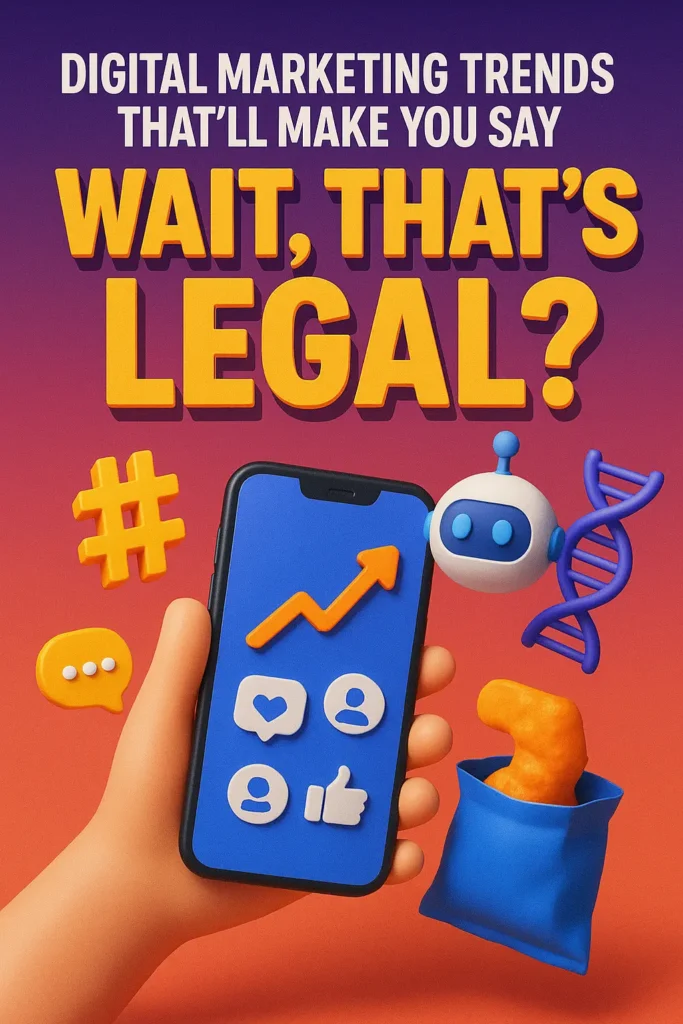
Buckle up, grab your phone (you already were holding it, weren’t you?), and let’s explore the digital trends so bizarre, you’ll do a double-take.
1. Hyper-Personalization: When Ads Know You Better Than Your Mom
Once upon a time, personalization meant getting an email that said:
“Dear, we value your business.”
Cute, right? Now, hyper-personalization is out here casually diagnosing your caffeine addiction before you do.
Remember when ads used to be generic? Like a toothpaste ad showing a random person smiling at nothing in particular? Well, those days are gone. Now, thanks to hyper-personalization in digital marketing, brands know you better than your best friend.
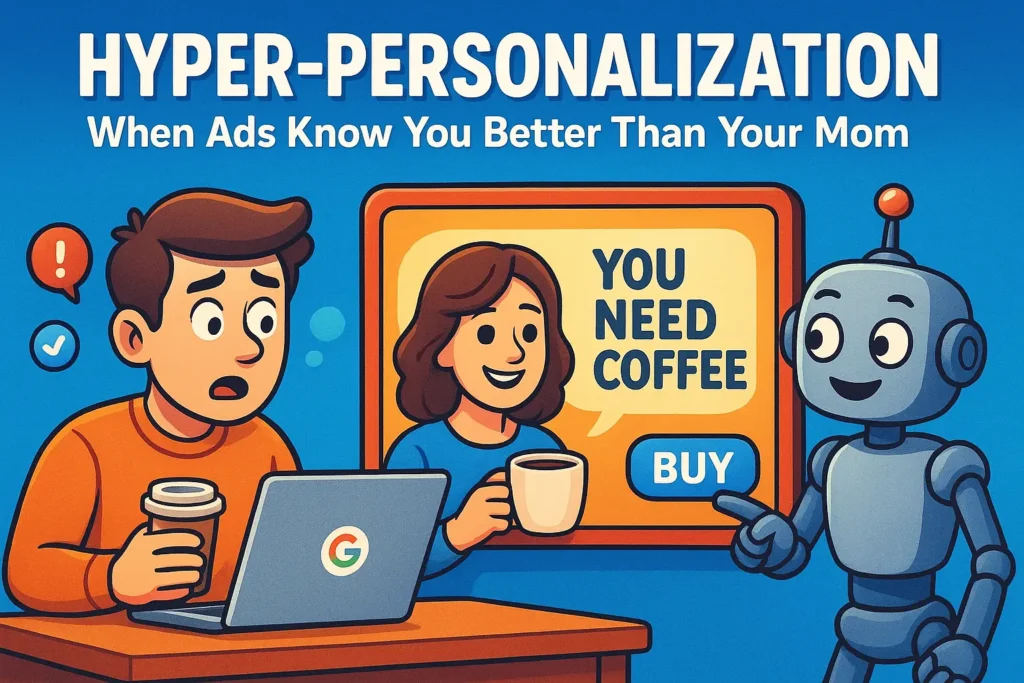
Funny Example
It’s like when your mom somehow knew you skipped lunch and magically cooked your favorite dish. Only this time, it’s not mom—it’s an algorithm stalking your Google searches.
Real-World Case
Starbucks uses personalized push notifications based on what’s the weather outside and what location you live in. If it’s a hot day, you might get a coupon for a Frappuccino. If it’s cold, they’ll nudge you toward a latte. That’s personalization at work!
2. Voice Search: Alexa, Google, and Siri Are Now Your Assistants.
With smart speakers everywhere, people are ditching typing. Instead of Googling “best pizza near me,” we now yell at Alexa: “Alexa, where can I get pizza that doesn’t taste like cardboard?”
Why It Matters
Marketers now optimize content for how humans talk, not how they type. That means your website needs to answer conversational questions like: “What’s the cheapest phone with a camera that won’t make me look like a potato?”
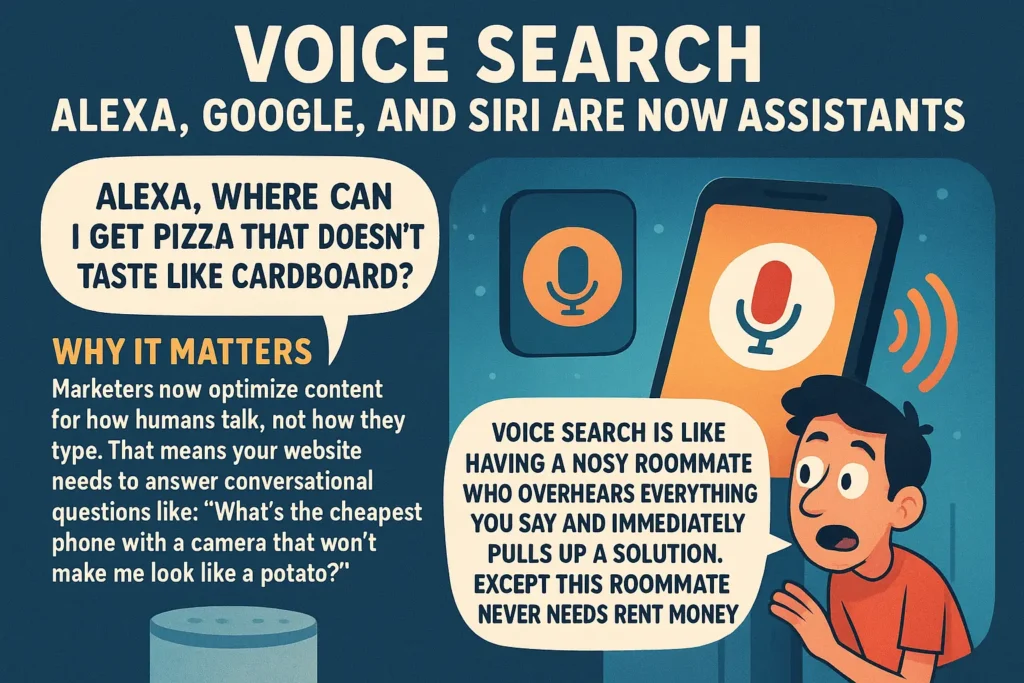
Humorous Analogy
Voice search is like having a nosy roommate who overhears everything you say and immediately pulls up a solution. Except this roommate never needs rent money.
Beginner-friendly tip:
If you’re a brand and you’re not optimizing for voice, you’re basically ignoring the fact that half of the population is too lazy to lift their thumbs anymore.
3. Visual Search: “I Don’t Know What It’s Called But I Want It” Mode.
Ever spotted someone on the subway with shoes so good you considered making lifelong friendship just to ask where they got them? Enter visual search.
Apps like Pinterest and Google Lens now let you take a photo and shop instantly. It’s shopping for introverts: no small talk, no awkward “um, cool shoes, where’d you…”
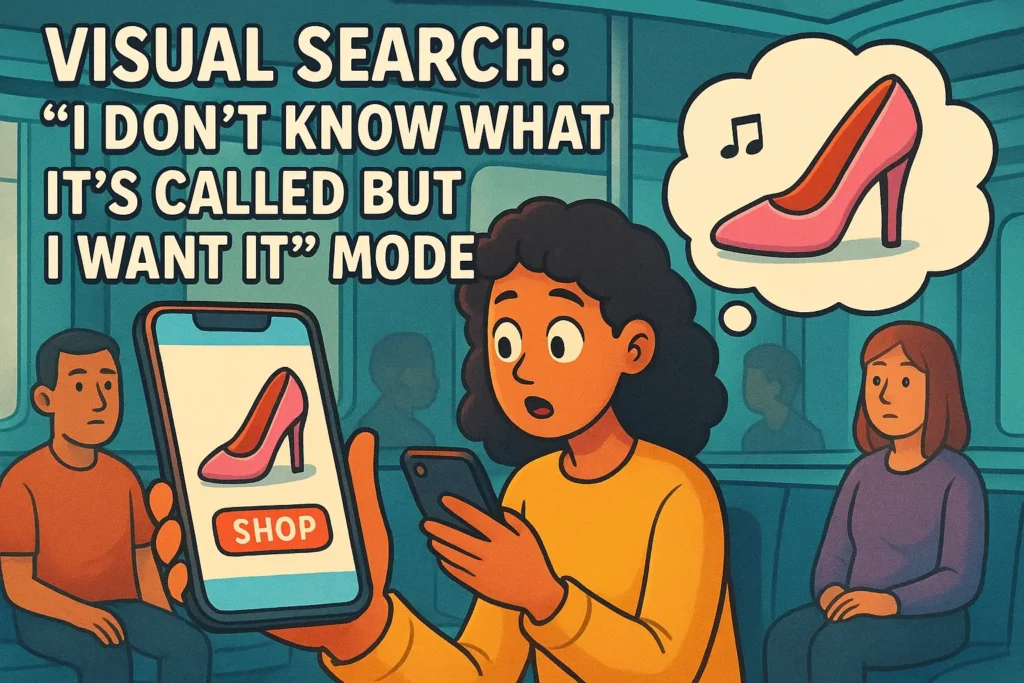
Funny story idea:
A friend once uploaded a picture of their neighbor’s lawn chair to find the exact model. They ended up accidentally spending rs.2000 because “apparently there are chairs that massage and connect to Bluetooth.” Visual search isn’t just shopping—it’s a trap with WiFi.
Why It’s Wild
Now your camera is basically a shopping assistant. Suddenly, impulse shopping has become Olympic-level easy. See it. Snap it. Own it. Goodbye savings account.
4. Social Commerce: Turning Scrolling Into Shopping.
We used to open Instagram or TikTok to watch cat videos and dance trends. Now? They’re full-blown shopping malls.
Example:
You watch one TikTok about a hairbrush. Suddenly, TikTok Shop is offering it with free shipping, reviews pop up in the comments, and before you know it—you’re holding the brush two days later thinking: “Wow, did I need this? Or was I hypnotized?”
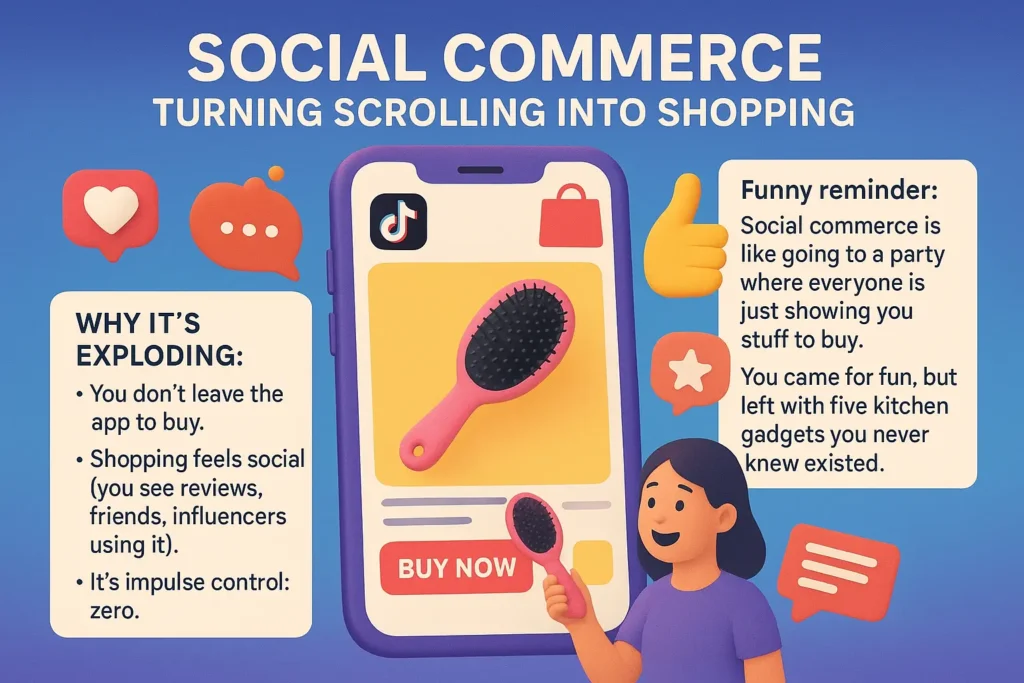
Why it’s exploding:
• You don’t leave the app to buy.
• Shopping feels social (you see reviews, friends, influencers using it).
• It’s impulse control: zero.
Visit Instagram to check yourself!
Funny reminder:
Social commerce is like going to a party where everyone is just showing you stuff to buy. You came for fun, but left with five kitchen gadgets you never knew existed.
5. Shoppable Livestreams: QVC Got Cool Again.
Remember old TV shopping channels with cheesy hosts? Now they’ve been reborn on TikTok, YouTube, and Instagram—but cooler and faster.
Influencers go live, show off products in real time, and you can tap the screen to buy instantly.
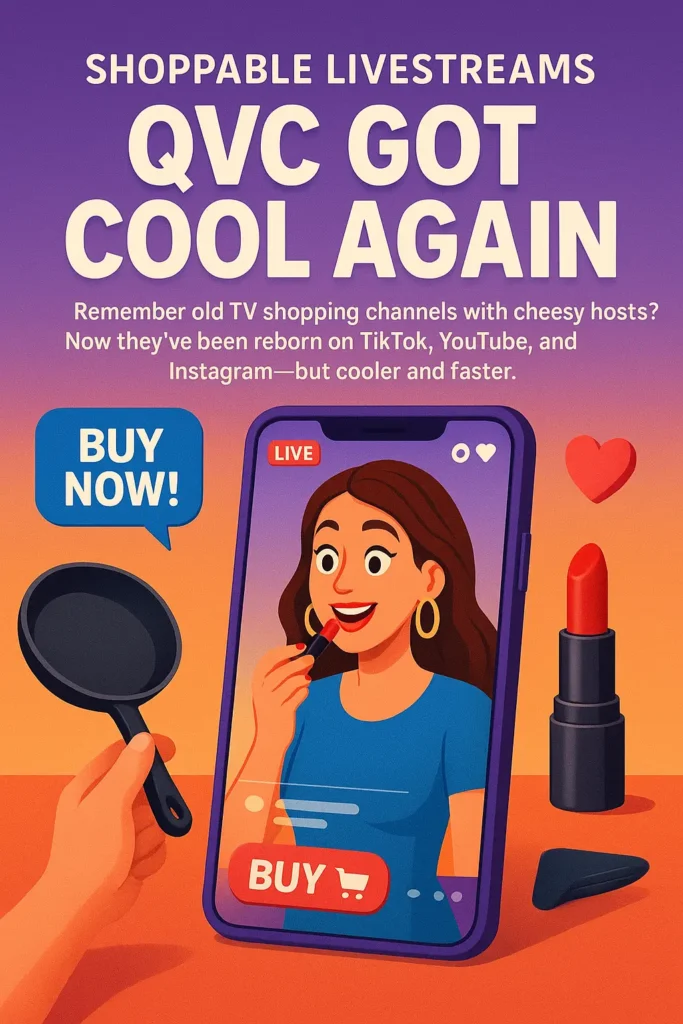
Example:
A live streamer once sold 3,000 frying pans in 15 minutes. That’s a lot of omelets.
An influencer tests out lipsticks live, answers questions, and bam! you can buy the exact shade in one click. No more “Where’d she get that?” mysteries.
Funny thought:
It’s like going to a concert, but instead of leaving with memories or merch, you leave with nonstick cookware.
It’s like crashing your friend’s makeup session and impulsively buying everything she uses—except your friend is followed by 2 million people.
6. AR & VR Shopping: Try Before You Buy (Without Getting Out of Bed)
One of the coolest digital marketing trends right now that feels like sci-fi: trying on clothes, glasses, or even makeup virtually.
Examples:
• Use your front camera and check how a sofa looks in your living room.
• Try on sunglasses using a selfie filter.
• Test different lipstick shades on your face… in 3D.
IKEA has an app that lets you drop a 7-foot sofa in your tiny apartment. Spoiler: the sofa always looks great until you trip over the imaginary 3D edge with your actual legs.
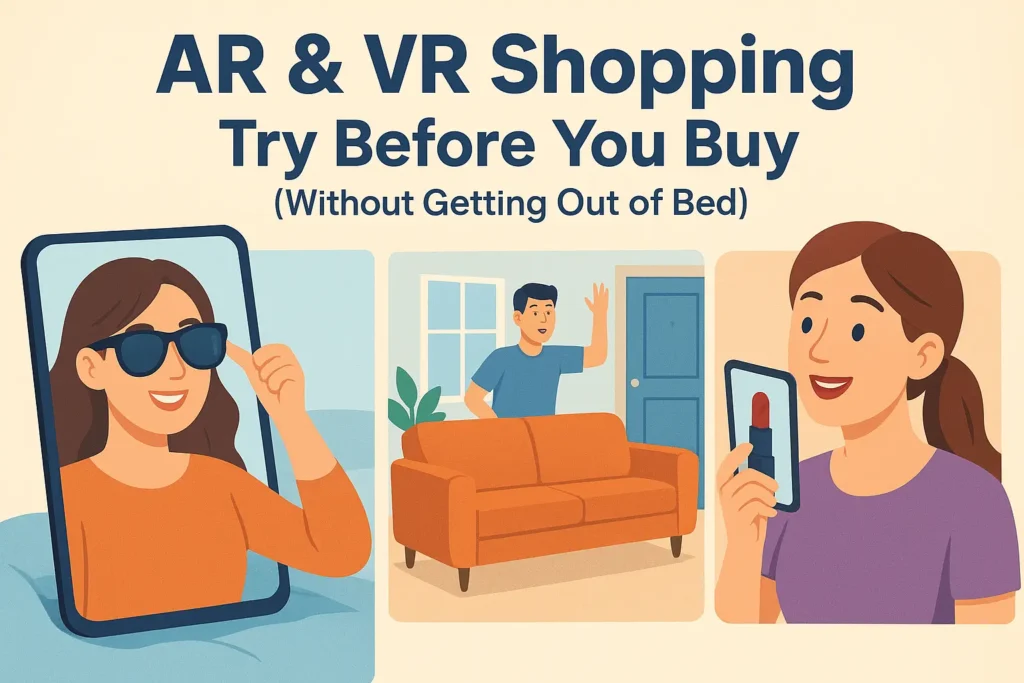
Humor angle:
AR shopping proves we trust technology too much. If IKEA tells us “This couch fits,” we’ll ignore the fact it will block the only doorway in your studio apartment because the app showed you smiling next to it.
Beginner lesson:
For marketers, AR builds trust. For customers, it saves you the trouble of apologizing to your landlord when you lodge a 2-seater into the elevator sideways.
7. Zero-Click Content: Answers Without Clicks.
Marketers have learned that sometimes people don’t want to click on websites. So now, brands create zero-click content—stuff that fully answers your question inside TikTok, Instagram, or Google results.
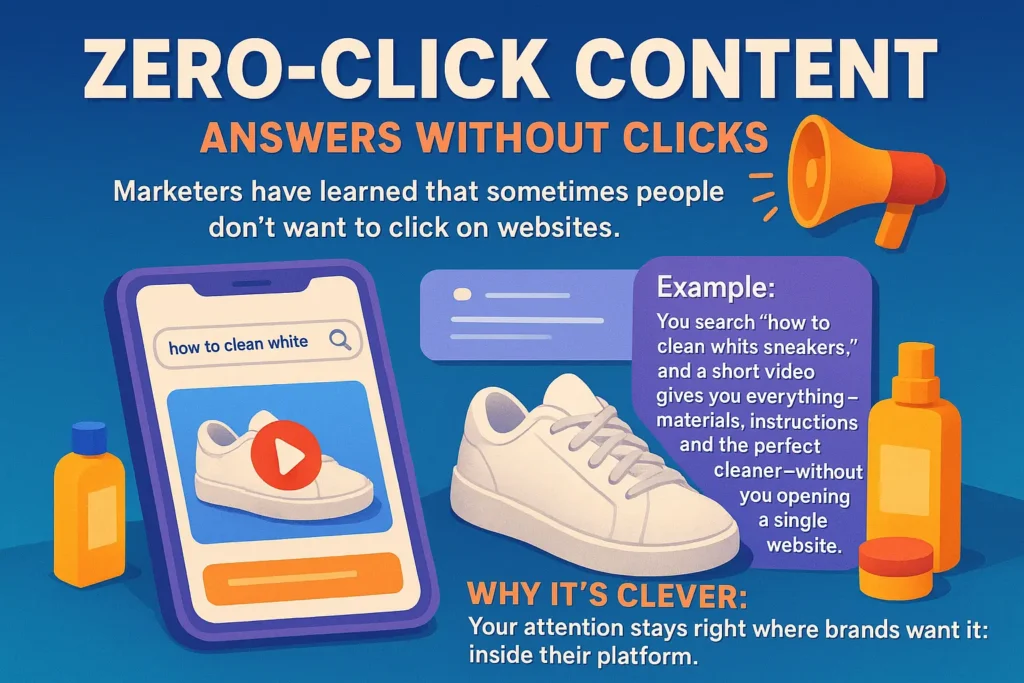
Example:
You search “how to clean white sneakers,” and a short video gives you everything—materials, instructions, and the perfect cleaner—without you opening a single website.
Why it’s clever:
Your attention stays right where brands want it: inside their platform.
Check out the website for more info : Giggledesk
8. Meme Marketing: Because Laughter = Engagement.
Brands have discovered that memes spread faster than wildfire on the internet. The funnier, the better. And when done right, it feels like a friend sharing a joke rather than a company selling you something.
Example:
When Netflix tweets a meme about procrastinating on homework, you don’t just laugh—you retweet it. Suddenly, the brand feels human.
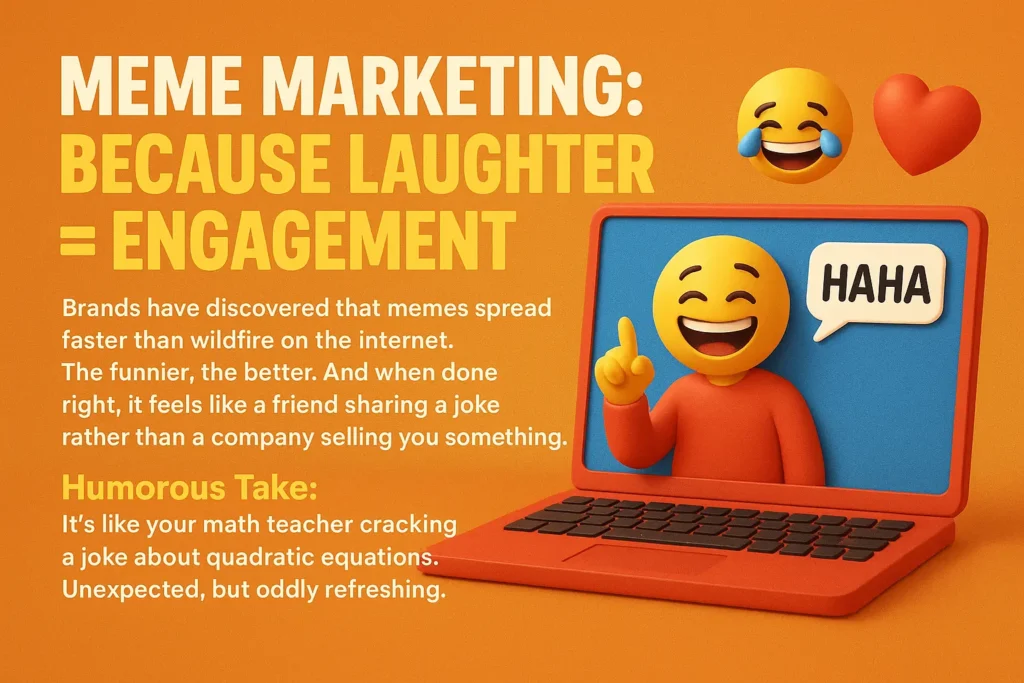
Humorous Take:
It’s like your math teacher cracking a joke about quadratic equations. Unexpected, but oddly refreshing.
9. Ephemeral Content: Blink and It’s Gone.
When you post stories on Instagram, Snapchat and even Facebook, it disappears in 24 hours. And yet, people are addicted. Why? FOMO. Nobody wants to miss out.
Example:
It’s like your favourite restaurant saying: “We’ll serve this burger for one day only.” Of course, you rush to try it. Ephemeral content works the same way.
Humorous Twist:
Basically, brands are saying: “This will self-destruct in 24 hours.” And somehow, that makes us more curious.
10. Data Ethics: The Big “Are You Sure That’s Legal?” Question.
Here’s the tricky part. All these digital marketing trends depend on one thing: your data.
Your clicks, your searches, your late-night cravings—it’s all fuel for personalization. But this raises the million-dollar question: is it okay that brands know so much?
Funny way to put it:
It’s like dating. On one hand, you love that someone remembers your favorite ice cream. On the other hand, if they also know your Netflix watch history from last night. Maybe that’s too much info.
Expect to see more focus on privacy, opt-outs, and ethical tracking in future marketing.
Conclusion:
The Future of Digital Marketing is Here—Are You Ready?
Digital marketing isn’t just about catchy slogans or a well-placed Instagram ad anymore—it’s a dynamic ecosystem fueled by technology, psychology, and creativity. Trends like hyper-personalization, AI-powered predictions, and shockingly precise ad targeting are already pushing the boundaries of what marketers can do, blending the line between innovative and intrusive. These tools enable brands to connect with their audience more deeply than ever before, offering experiences so tailored that they can feel uncanny. But remember, despite all the futuristic bells and whistles, the most successful marketing is still rooted in trust, authenticity, and value for the user.
Marketers need to embrace these changes with an open mind—experiment with AI chatbots, explore voice search optimization, or dabble in VR and AR for immersive customer experiences. However, it is essential to use these powers thoughtfully: transparency, ethics, and user data protection must remain a priority. Those who use digital marketing’s evolving tools responsibly will cultivate loyalty and stand out from the noise.
Whether you’re a seasoned marketer or just starting out, staying agile is your greatest asset. Take these trends as your springboard—test, learn, adapt, and above all, respect your audience. The future of digital marketing isn’t just coming; it’s already here, rewriting the rulebook and rewarding those brave enough to play by the new rules.

Really enjoyed reading this! The humor mixed with real-world digital marketing insights made it super engaging and easy to understand 👏🔥
Loved this blog! You managed to make digital marketing sound both fun and futuristic, can’t wait to read your next one 🙌
Loved the clarity in this blog!
I like your observation and the way you quote them in your writings
[…] check the digital marketing trends to know more about the […]